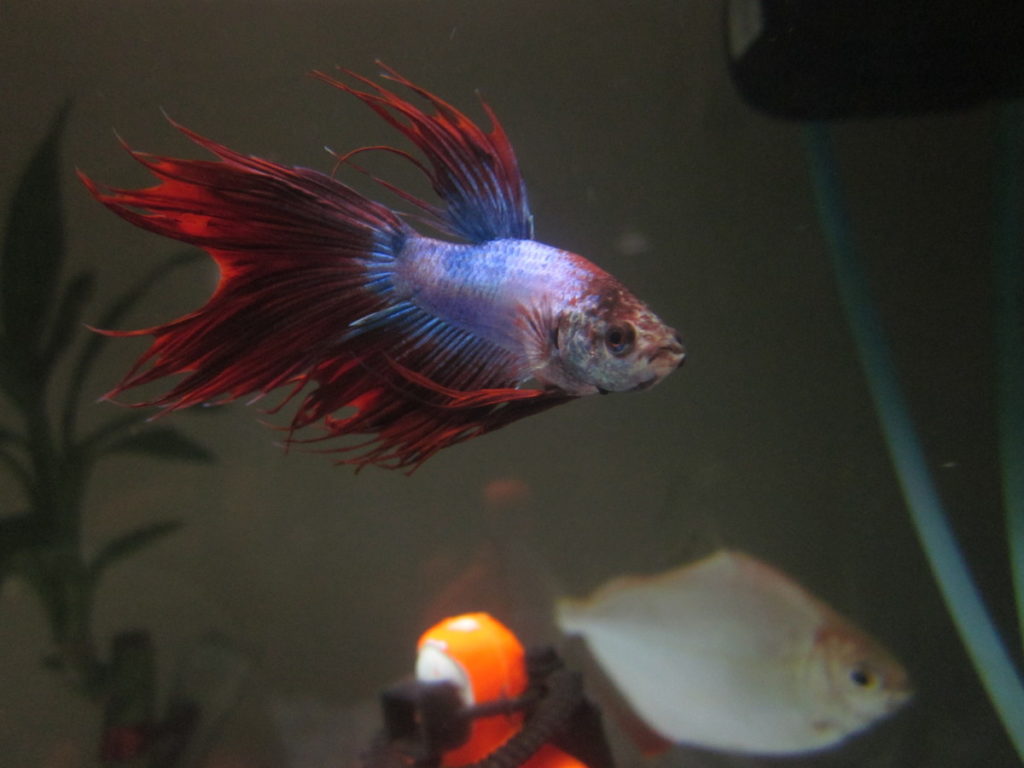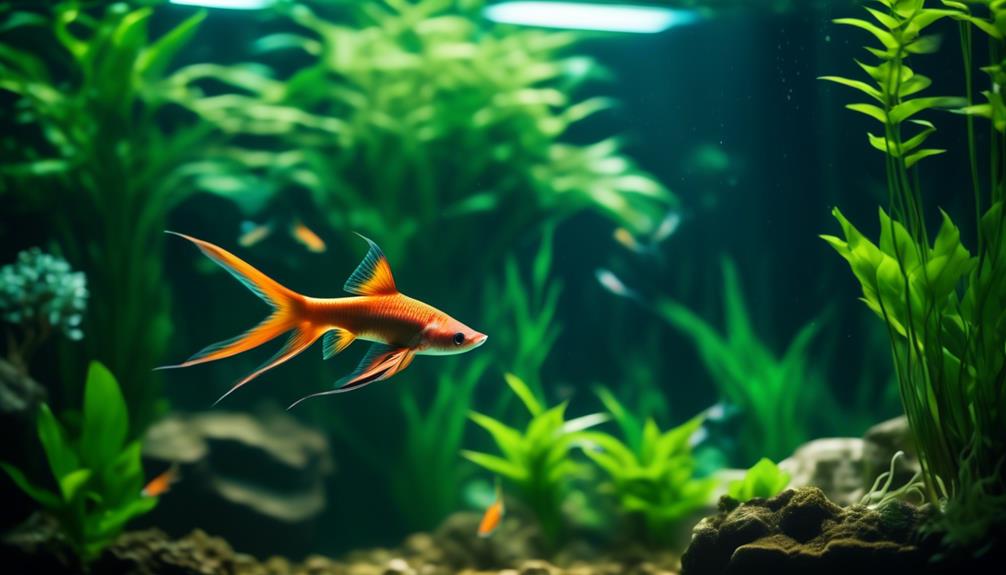
Are you searching for a freshwater fish that is as hardy and peaceful as a gentle breeze on a calm summer day? Look no further than the swordtail fish.
With its vibrant colors and distinctive sword-like tail, this small beauty is sure to catch your eye. But there’s more to discover about this fascinating creature.
From its suitable tank mates to its care and feeding requirements, this article will take you on a journey into the world of swordtails.
So, get ready to dive into the depths of knowledge and uncover the secrets of these hardy and peaceful fish.
Key Takeaways
- Swordtails are small, non-aggressive freshwater fish that are suitable for beginner aquarists.
- They can coexist with small livebearers and smaller species of tetras, but should not be kept with larger predatory fish.
- Swordtails thrive in clean water and require large open spaces for swimming.
- Breeding swordtails is relatively easy, but pregnant females should be separated and adequate hiding spaces should be provided for the fry to survive.
Swordtail Fish Description
Swordtails, small freshwater fish with a non-aggressive temperament, make excellent additions to your aquarium. These fish are known for their small size and can thrive in a medium-sized aquarium of around 30 gallons. They’re versatile swimmers and can be found in all regions of the tank.
When it comes to tank mates, swordtails get along well with mollies, platys, guppies, and other small livebearers. They can also coexist with smaller species of tetras. However, it’s important to avoid keeping them with larger predatory fish like cichlids. Swordtails are generally peaceful and make great community fish. It’s advisable to keep one male with several females to prevent aggression.
Taking care of swordtails is relatively easy, as they’re hardy and suitable for beginner aquarists. They can survive in various aquarium conditions but thrive in clean water. Adding a small amount of salt to the tank is also beneficial. Swordtails require large open spaces for swimming, so make sure to provide enough room. Additionally, it’s important to cover the aquarium as swordtails are powerful jumpers.
When it comes to feeding, swordtails are primarily herbivores. They can be fed flake-based foods or algae, and a varied diet is beneficial for their health. Occasionally, you can offer them live or frozen foods like brine shrimp. It’s best to feed them in small portions multiple times a day.
Lastly, swordtails are known for their prolific breeding. They reach sexual maturity at around three months old. Pregnant females should be moved to separate breeding tanks to protect the fry, as swordtails will eat their own offspring. Using a breeding box or heavily planted aquarium can help provide hiding spaces for the fry to survive.
Suitable Tank Mates
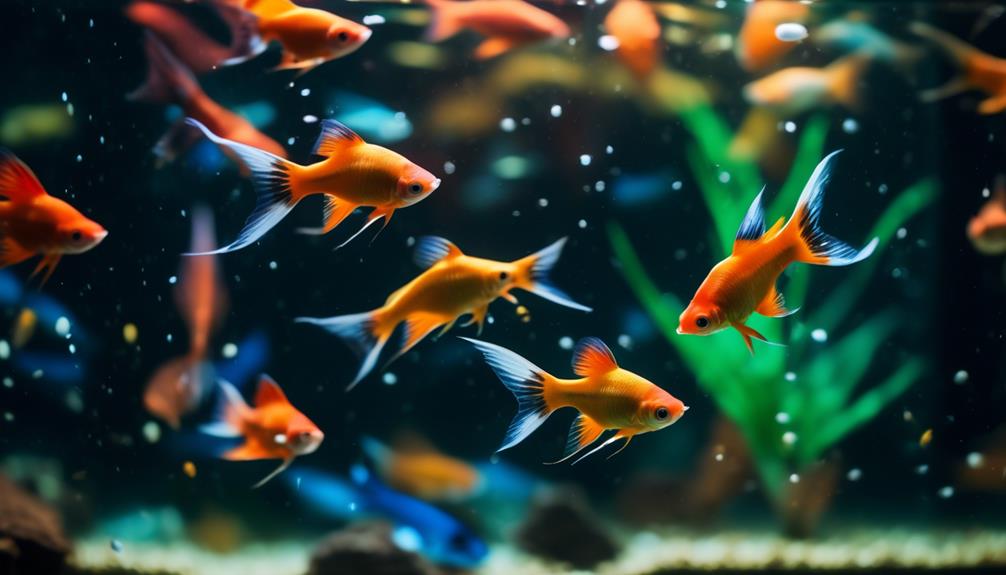
To ensure a harmonious aquarium, consider compatible tank mates for your swordtail fish. Mollies, Platys, Guppies, and other small livebearers make great companions for swordtails. You can also introduce smaller species of tetras into the tank.
However, it’s important to avoid keeping swordtails with larger predatory fish like cichlids. Swordtails are generally peaceful and make excellent community fish.
To prevent aggression, it’s advisable to house one male with several females. This helps to maintain a balanced ratio and reduces the chances of territorial disputes.
Swordtail Care
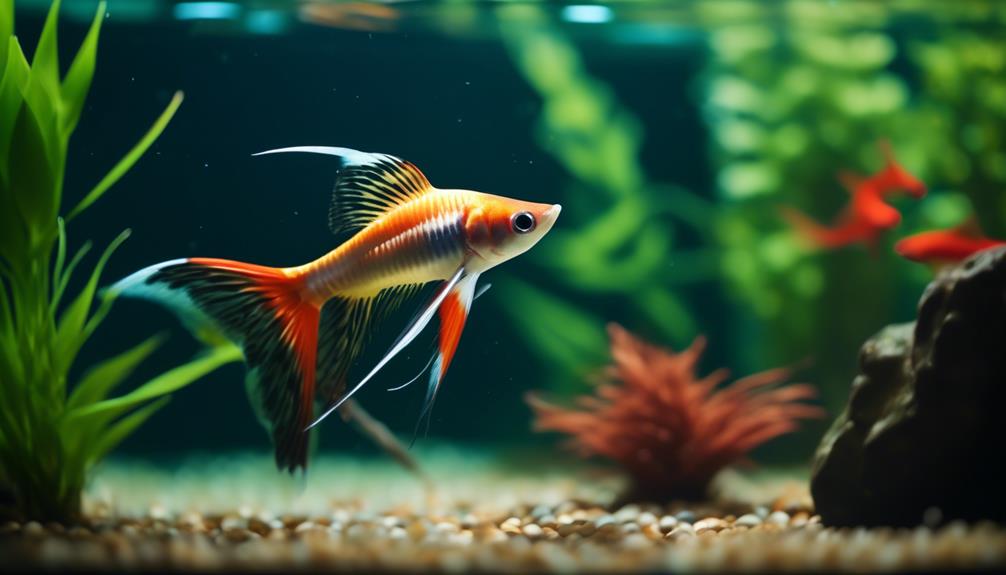
After considering suitable tank mates, it is essential to understand the care requirements for swordtail fish. Swordtails are relatively hardy and suitable for beginner aquarists. They can survive in a range of aquarium conditions but thrive in clean water. Adding a little bit of salt to the aquarium is advisable. Swordtails require large open spaces for swimming, so it is important to provide them with a medium-sized aquarium of at least 30 gallons. Care should be taken to cover the aquarium as they are powerful jumpers. Feeding swordtails is relatively easy as they are primarily herbivores. Flake-based foods or algae can be their main diet, but providing a varied diet is beneficial for their health. Live or frozen foods like brine shrimp can be occasionally offered. It is recommended to feed them in small portions multiple times a day. Breeding swordtails is also relatively simple as they reproduce prolifically. They reach sexual maturity at around three months old, and pregnant females should be removed into separate breeding tanks. Swordtails will eat their own fry, so using a breeding box or heavily planted aquarium is recommended. Adequate hiding spaces should be provided for the fry to survive.
| Care Requirements | Tips and Recommendations |
|---|---|
| Water Conditions | – Swordtails thrive in clean water. – Adding a little bit of salt to the aquarium is advisable. |
| Tank Size | – Swordtails require a medium-sized aquarium of at least 30 gallons. |
| Swimming Space | – Swordtails need large open spaces for swimming. |
| Feeding | – Provide a varied diet with flake-based foods, algae, and occasional live or frozen foods. |
| Breeding and Fry Survival | – Separate pregnant females into breeding tanks. – Use a breeding box or heavily planted aquarium. |
Feeding Swordtails
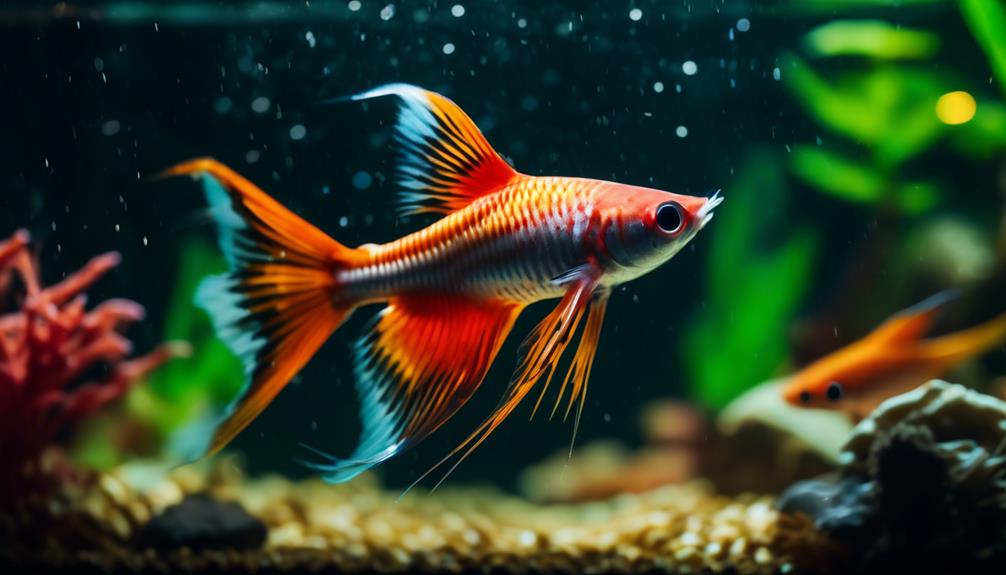
Feeding swordtails is a straightforward process that involves providing them with a varied diet of flake-based foods, algae, and occasional live or frozen foods to ensure their health and well-being.
As primarily herbivores, swordtails can be fed flake-based foods or algae, which serve as their main source of nutrition. However, it’s beneficial to offer them a varied diet to promote optimal health.
Occasionally, you can supplement their diet with live or frozen foods like brine shrimp. When feeding swordtails, it’s recommended to provide small portions multiple times a day, rather than one large feeding, to prevent overeating and maintain water quality.
Breeding Swordtails
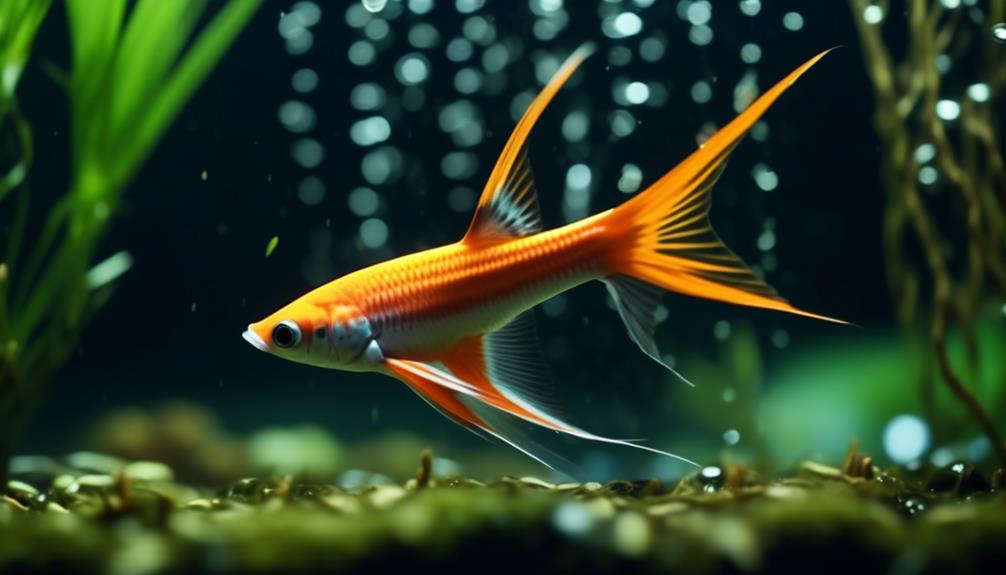
Breeding swordtails is a relatively effortless process, making them a popular choice for aquarists looking to expand their fish population. These hardy fish reach sexual maturity at around three months old, and pregnant females should be removed into separate breeding tanks. To ensure the survival of the fry, it is recommended to use a breeding box or heavily planted aquarium, as adult swordtails tend to eat their own offspring. Providing adequate hiding spaces for the fry is crucial. Here is a table highlighting the key steps in breeding swordtails:
| Step | Description |
|---|---|
| 1 | Separate pregnant females into breeding tanks |
| 2 | Use a breeding box or heavily planted aquarium |
| 3 | Provide hiding spaces for the fry |
Breeding swordtails can be a rewarding experience, and with minimal effort, you can enjoy a growing population of these peaceful and beautiful fish in your aquarium.
Freshwater Habitat
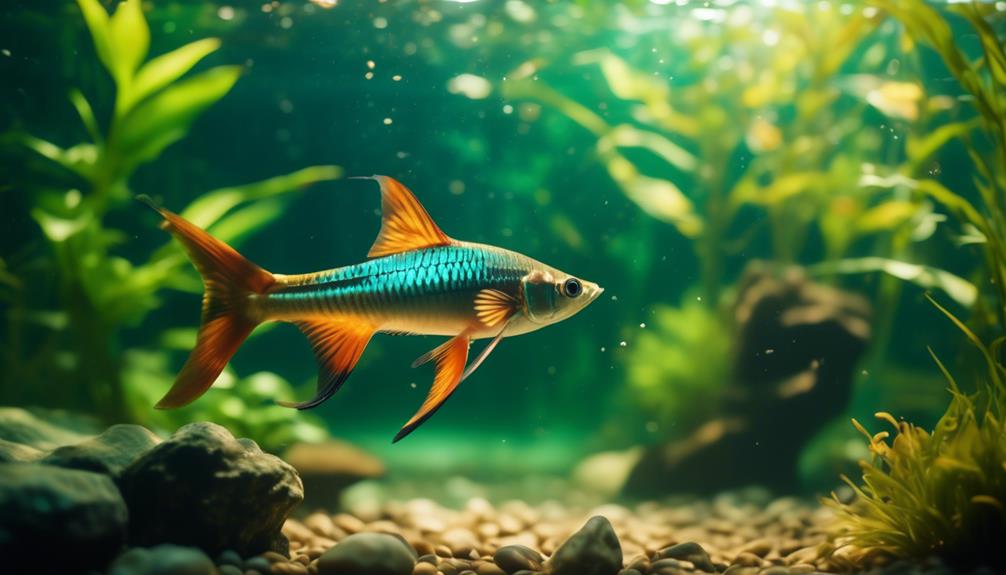
To fully understand the needs of swordtail fish, it’s essential to explore their natural freshwater habitat. Swordtails originate from Central America, specifically Mexico, where they inhabit slow-moving rivers, streams, and lakes. These bodies of water are characterized by warm temperatures ranging from 72 to 82 degrees Fahrenheit (22-28 degrees Celsius).
The water in their natural habitat is usually slightly alkaline with a pH level of around 7.5. Swordtails thrive in well-oxygenated water and prefer a moderate water current. The presence of live or artificial plants provides them with hiding spots and helps recreate their natural environment.
Additionally, swordtails appreciate a spacious tank with plenty of open swimming areas. By replicating their natural freshwater habitat, you can ensure the health and well-being of these hardy and peaceful fish.
Non-Aggressive Temperament
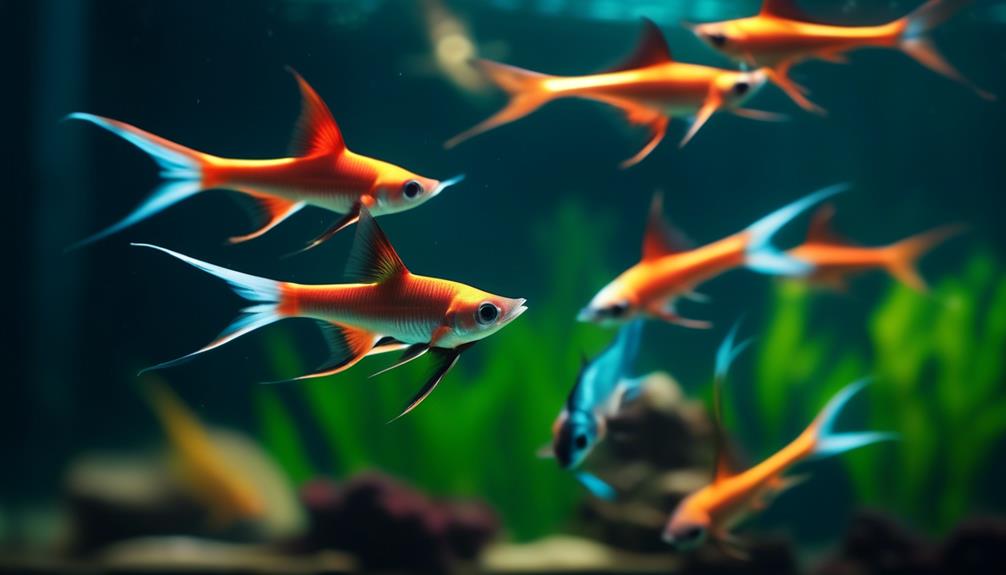
Swordtail fish are known for their non-aggressive temperament, making them a great choice for peaceful community aquariums. They are generally peaceful and make excellent community fish, as long as they are not housed with larger predatory fish like cichlids. To prevent aggression, it is advisable to house one male with several females. Here is a table summarizing suitable tank mates for swordtails:
| Suitable Tank Mates | Unsuitable Tank Mates |
|---|---|
| Mollies | Cichlids |
| Platys | Large predatory fish |
| Guppies | |
| Smaller tetras |
With their calm demeanor, swordtails create a harmonious environment in the aquarium. They are relatively hardy and suitable for beginner aquarists. Just ensure the tank is adequately covered as they are powerful jumpers. Overall, swordtail fish are peaceful companions that bring tranquility to any community aquarium.
Ideal Aquarium Size
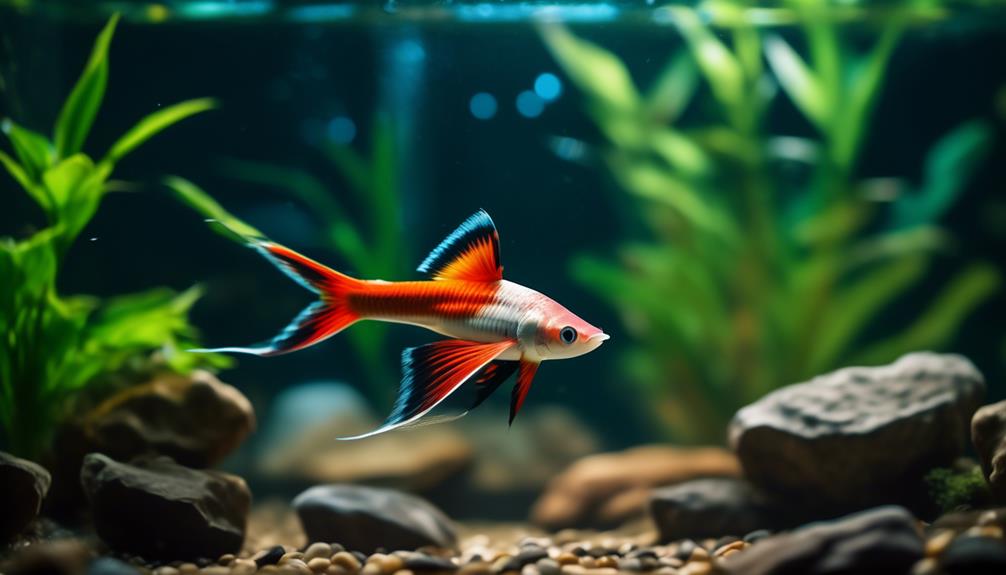
When considering the ideal aquarium size for swordtail fish, it’s important to provide them with ample space to swim and thrive. Swordtails require a medium-sized aquarium, preferably around 30 gallons. This size allows them to swim freely and explore their surroundings.
Swordtails are known to swim in all regions of the tank, so it’s important to provide them with large open spaces. Additionally, covering the aquarium is crucial as swordtails are powerful jumpers. A covered tank prevents them from escaping and ensures their safety.
Habitat Regions
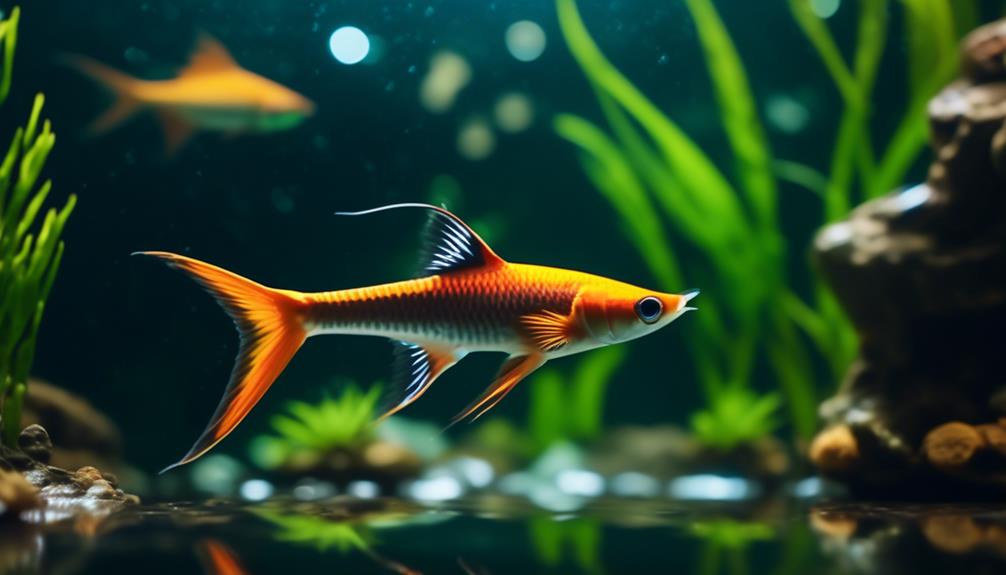
In their natural habitat, swordtail fish can be found swimming in various regions of the water. They’re adaptable creatures that can thrive in different parts of the tank, creating a lively and dynamic environment.
Here are three reasons why the habitat regions of swordtail fish evoke a sense of wonder and fascination:
- Surface Dwellers: Swordtails often explore the topmost layer of the water, gracefully gliding near the surface. Watching them break through the water’s surface and interact with the air above can be mesmerizing.
- Middle Zone Explorers: These fish are known for their agility and love to explore the middle portion of the tank. They dart and weave through plants and decorations, creating an exciting display of movement.
- Bottom Dwellers: Swordtails also venture to the lower regions, gracefully maneuvering around rocks and caves. Observing them as they gracefully glide along the bottom brings a sense of tranquility to the tank.
The diverse swimming habits of swordtail fish add depth and beauty to any aquarium, captivating the observer with their natural elegance.
Community Fish
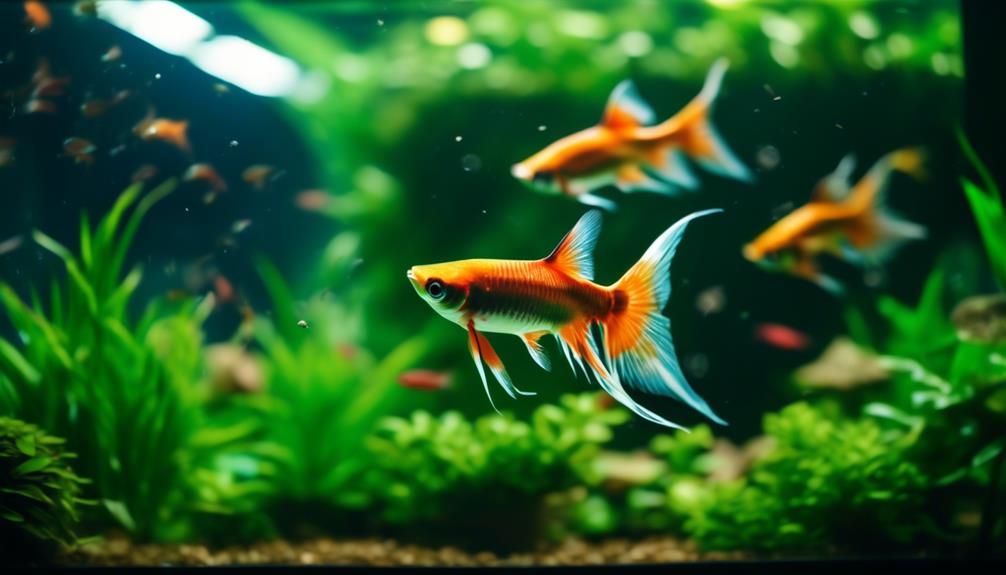
As you explore the diverse swimming habits of swordtail fish, you’ll also discover the joy of keeping them as community fish. Swordtails are peaceful and make excellent tank mates for other small livebearers like mollies, platys, and guppies. They can also coexist with smaller species of tetras.
However, it’s important to avoid keeping them with larger predatory fish such as cichlids. To prevent aggression, it’s advisable to house one male with several females. Swordtails are relatively hardy and suitable for beginner aquarists. They can survive in a range of aquarium conditions but thrive in clean water.
It’s recommended to add a little bit of salt to the aquarium. Just remember to provide large open spaces for swimming and cover the tank as swordtails are powerful jumpers.
Hardy and Resilient Species
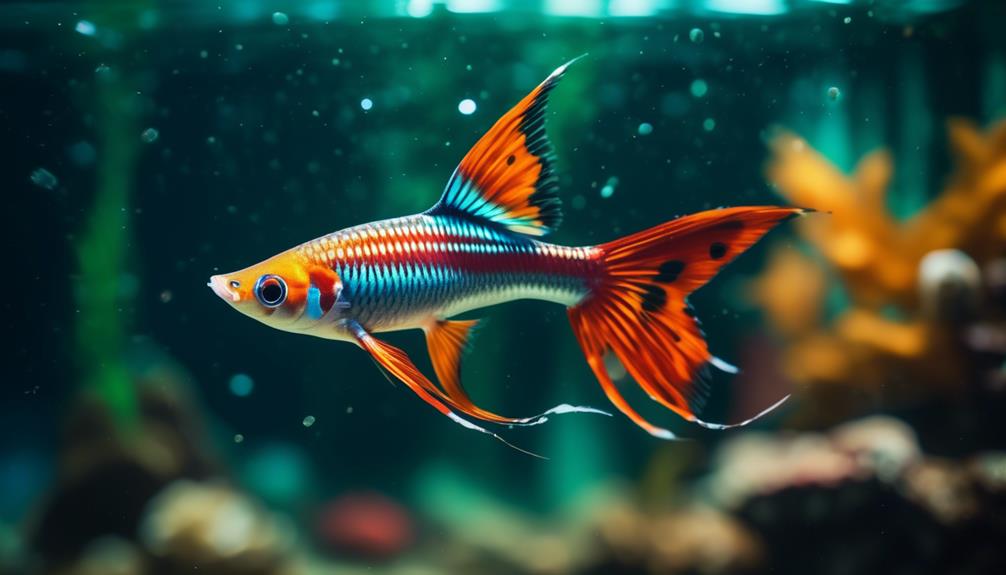
Swordtail fish are known for their hardiness and resilience, making them an excellent choice for beginner aquarists. These fish possess incredible adaptability and can withstand a wide range of water conditions, ensuring a greater chance of survival in your aquarium.
Their ability to thrive in different environments evokes a sense of admiration and awe. Not only can they tolerate various water parameters, but swordtails also exhibit a remarkable ability to recover from stressful situations, proving their resilience.
This quality makes them ideal for those who may be new to fishkeeping or who may be worried about the fragility of their aquatic pets. With swordtail fish, you can rest assured that you have chosen a species that can endure and overcome challenges, bringing peace of mind to any aquarist.
Water Conditions and Salinity
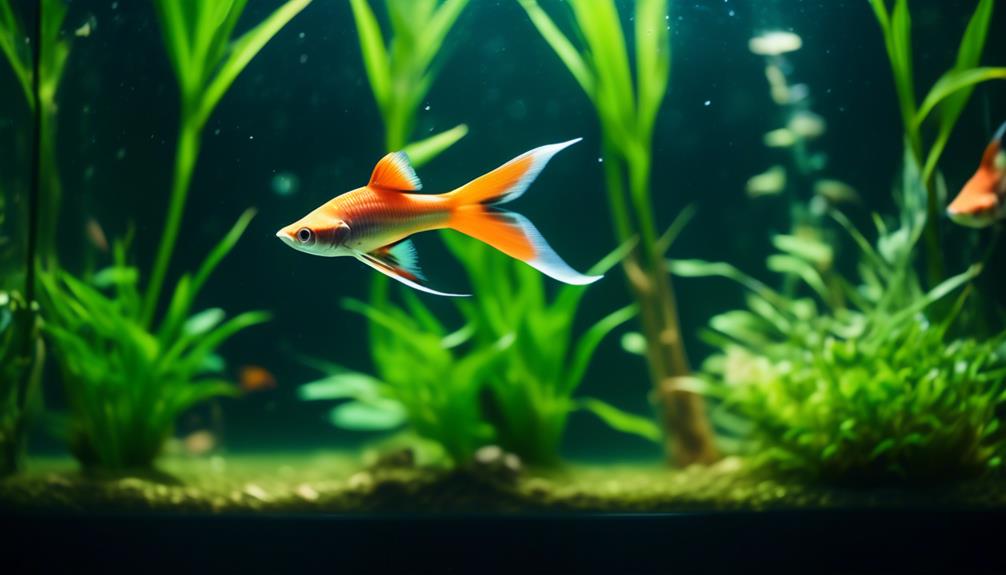
With their remarkable adaptability and resilience, swordtail fish can’t only withstand a variety of water conditions, but they also exhibit a unique response to salinity levels in their aquarium environment.
Swordtails are freshwater fish that can survive in a range of water parameters. However, they thrive in clean water, so maintaining good water quality is essential. Adding a small amount of salt to the aquarium is advisable, as swordtails appreciate a slightly saline environment.
It’s important to monitor the salinity levels to ensure they’re within the appropriate range for swordtails, as excessively high or low salinity can be harmful to their health.
Breeding Tips and Considerations
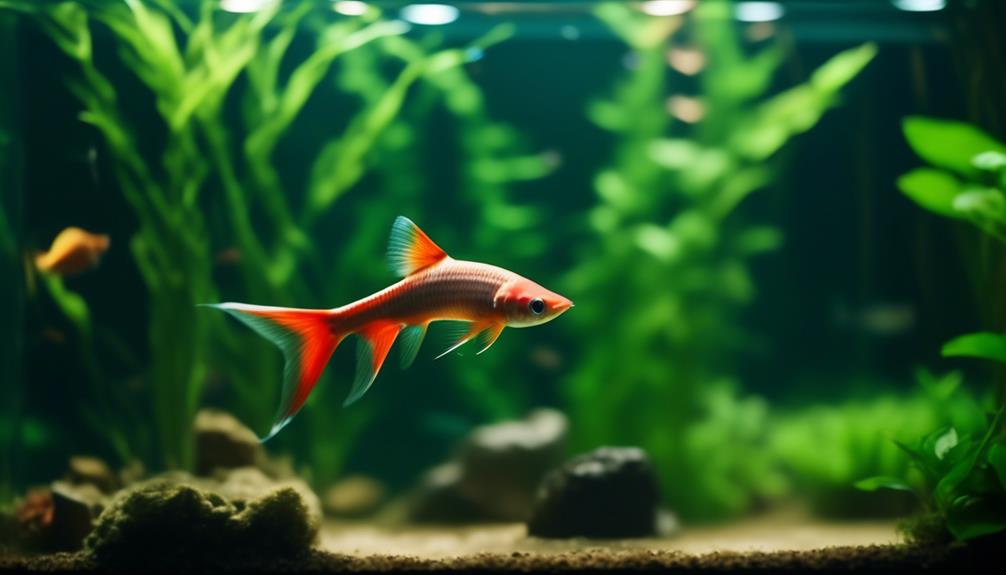
To successfully breed swordtail fish, consider these tips and important factors:
- Provide a separate breeding tank or use a breeding box to protect the fry from being eaten by adult fish. This ensures the survival of the young ones and allows them to grow in a safe environment.
- Make sure to remove pregnant females from the main tank and place them in the breeding tank. This prevents stress and aggression from other fish, allowing the pregnant female to give birth in peace.
- Create ample hiding spaces for the fry to seek shelter. This can be achieved by adding live plants or artificial decorations that provide cover. Hiding spots are essential for the survival and growth of the fry.
Frequently Asked Questions
How Large Do Swordtail Fish Grow?
Swordtail fish grow to varying sizes depending on their gender. Males can reach up to 4 inches in length, while females are slightly larger, growing up to 6 inches.
Can Swordtails Be Kept With Aggressive Fish Species?
No, swordtails should not be kept with aggressive fish species. They are generally peaceful and make excellent community fish. It is advisable to house one male with several females to prevent aggression.
What Are Some Common Health Issues That Swordtail Fish May Experience?
Some common health issues that swordtail fish may experience include fin rot, ich (white spot disease), and swim bladder disorder. Regular water maintenance, proper diet, and a stress-free environment can help prevent these problems.
How Long Do Swordtail Fish Typically Live?
Swordtail fish typically live for about 3 to 5 years. They can live longer with proper care. Providing a suitable tank, clean water, and a varied diet will help ensure their longevity.
Are There Any Specific Water Parameters That Swordtail Fish Require for Optimal Health?
For optimal health, swordtail fish require clean water with suitable water parameters. They can tolerate a range of conditions, but maintaining stable temperature, pH, and hardness levels is important. Regular water changes and monitoring are necessary to ensure their well-being.
What makes Swordtail Fish peaceful in comparison to Scat Fish?
The Swordtail Fish is known for its tranquil nature, which makes it a popular choice for community tanks. In contrast, the fascinating world of scat fish can be quite aggressive, especially when it comes to competing for food and territory. This is what makes Swordtail Fish peaceful in comparison to scat fish.
Conclusion
In conclusion, the swordtail fish is a perfect choice for beginner aquarists looking for a hardy and peaceful addition to their tank.
With their vibrant colors, distinctive tails, and non-aggressive temperament, they make for stunning and harmonious community tank inhabitants.
Swordtails thrive in clean water and are relatively easy to care for and breed.
So, if you’re looking to add some beauty and tranquility to your aquarium, the swordtail fish is the way to go.

